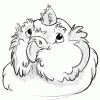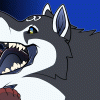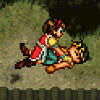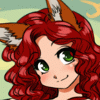
Basically seen a couple of people talking about this so I doodled this up to try and help out.
When you are making a bipedal anthropomorphic animal, bear in mind the way it's limbs are configured.
Humans are plantigrade mammals, therefore if you blend then with another plantigrade animal, they are ALWAYS going to stand with their feet flat on the ground. Unless, as stated, they are a hybrid.
So if you blend them with say, a bear, a mustelid like a wolverine, or a lizard, you will always get a plantigrade result.
Other plantigrade species include (but are not limited to) raccoons, opossums, rabbits, kangaroos, mice, red pandas, rats, hyraxes, skunks and hedgehogs.
In the leg diagram at the bottom you can see a few stances that I have outlined.
A is plantigrade, where all parts of the foot are on the ground when at rest or walking.
B is digitigrade, or walking on the toes, with the heel and wrist permanently raised off of the ground.
C is unguligrade, or walking on the nails, with the wrist/ankle and digits permanently off of the ground. Bear in mind that what is commonly referred to as the "knee" of unguligrade animals -in the forelimb- is the carpal or wrist joint.
D is a bird, which is also digitigrade, but arranged a little different to the mammals of diagram B. You can also see that the knee is placed quite high and it is usually hidden in the body feathers, which is why birds seem to have "backwards" knees when viewed. In reality this is their ankle.
E is a lizard. As you can see, lizards are plantigrade and walk on the whole of their foot. Even if they have pretty big feet. Also bear in mind that "lizard" does NOT include crocodiles and tuataras.
I hope this helps out somehow.
Shut up I only had mspaint.
When you are making a bipedal anthropomorphic animal, bear in mind the way it's limbs are configured.
Humans are plantigrade mammals, therefore if you blend then with another plantigrade animal, they are ALWAYS going to stand with their feet flat on the ground. Unless, as stated, they are a hybrid.
So if you blend them with say, a bear, a mustelid like a wolverine, or a lizard, you will always get a plantigrade result.
Other plantigrade species include (but are not limited to) raccoons, opossums, rabbits, kangaroos, mice, red pandas, rats, hyraxes, skunks and hedgehogs.
In the leg diagram at the bottom you can see a few stances that I have outlined.
A is plantigrade, where all parts of the foot are on the ground when at rest or walking.
B is digitigrade, or walking on the toes, with the heel and wrist permanently raised off of the ground.
C is unguligrade, or walking on the nails, with the wrist/ankle and digits permanently off of the ground. Bear in mind that what is commonly referred to as the "knee" of unguligrade animals -in the forelimb- is the carpal or wrist joint.
D is a bird, which is also digitigrade, but arranged a little different to the mammals of diagram B. You can also see that the knee is placed quite high and it is usually hidden in the body feathers, which is why birds seem to have "backwards" knees when viewed. In reality this is their ankle.
E is a lizard. As you can see, lizards are plantigrade and walk on the whole of their foot. Even if they have pretty big feet. Also bear in mind that "lizard" does NOT include crocodiles and tuataras.
I hope this helps out somehow.
Shut up I only had mspaint.
Category Artwork (Digital) / Tutorials
Species Unspecified / Any
Size 1202 x 1210px
File Size 36.7 kB

 FA+
FA+


















Comments